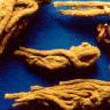
Angelica sinensis, commonly known as dong quai or female ginseng, is a herb belonging to the family Apiaceae, indigenous to China. Angelica sinensis grows in cool high altitude mountains in China, Japan, and Korea. The yellowish brown root of the plant is harvested in the fall and is a well-known Chinese medicine which has been used for thousands of years.

Scutellaria montana, with the common names largeflower skullcap, large-flowered skullcap and mountain skullcap, is an perennial forb first described by Alvan Chapman in 1878. This narrowly endemic species is found in the southeastern United States in parts of the Ridge and Valley and Cumberland Plateau Physiographic Provinces. Populations have been documented from four Tennessee counties and nine Georgia counties and is protected under the US Endangered Species act as it is a threatened species. The Latin specific epithet montana refers to mountains or coming from mountains.
Scutellaria barbata, the barbed skullcap, is a species of flowering plant in the mint family, Lamiaceae. It is native to Asia.
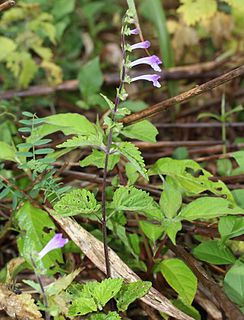
Scutellaria is a genus of flowering plants in the mint family, Lamiaceae. They are known commonly as skullcaps. The generic name is derived from the Latin scutella, meaning "a small dish, tray or platter", or "little dish", referring to the shape of the calyx. The common name alludes to the resemblance of the same structure to "miniature medieval helmets". The genus has a subcosmopolitan distribution, with species occurring nearly worldwide, mainly in temperate regions.

Scutellaria baicalensis, with the common name Baikal skullcap or Chinese skullcap, is a species of flowering plant in the family Lamiaceae.

Scutellaria lateriflora, known commonly as blue skullcap, mad dog skullcap, and side-flowering skullcap, is a hardy perennial herb of the mint family, Lamiaceae, native to North America.
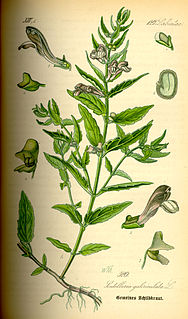
Scutellaria galericulata, the common skullcap, marsh skullcap or hooded skullcap, is a hardy perennial herb native to northern areas of the Northern Hemisphere, including Europe, Asia, and almost all of Canada. It is a member of the mint family. The form is upright and is usually 20 to 45 centimeters in height, sometimes reaching up to 80. It is a wetland-loving species and grows along fens and shorelines. The blue flowers are 1 to 2 centimeters long. The flowers are in pairs and are all on the same side of the stem. The flowers do not appear at the top of the stem.

Scutellaria incana, the hoary skullcap or downy skullcap, is a flowering plant in the family Lamiaceae and is native to North America. It is a perennial and is primarily found in the eastern United States as well as some parts of the Midwest.

Prochoreutis myllerana, Miller’s nettle-tap or small metal-mark, is a moth of the family Choreutidae found in Asia and Europe. Miller's nettle-tap was first described by Johan Christian Fabricius in 1794 from a specimen found in Sweden.

Scutellaria antirrhinoides is a species of flowering plant in the mint family known by the common names nose skullcap and snapdragon skullcap. It is native to the western United States, where it grows in forests, woodlands, and open, rocky habitat types. It is a perennial herb producing an erect stem or cluster of stems up to 35 centimeters tall from a system of thin rhizomes. The stems are coated in short hairs which are curled or angled upward and sometimes have resin glands. The oval leaves are coated in tiny hairs and are oppositely arranged. The lowest leaves are borne on short petioles. Flowers emerge from the leaf axils. Each flower is held in a calyx of sepals with a large ridge or appendage on the upper part. The corolla is up to 2 centimeters long, tubular in shape with a large upper and lower lip. The upper lip is folded into a beaklike protrusion and the lower has three flat lobes. The corolla is purple to blue with an area of white mottling on the lower lip.
Scutellaria bolanderi is a species of flowering plant in the mint family known by the common name Sierra skullcap. It is endemic to California, where it is known from the Sierra Nevada and several of the mountain ranges to the south. It is a perennial herb producing an erect stem or cluster of stems 30 centimeters to one meter tall from a system of thin rhizomes. The stems are coated in short, spreading hairs which sometimes have resin glands. The oval or heart-shaped leaves have wavy edges and are oppositely arranged. The lowest leaves are borne on short petioles. Flowers emerge from the leaf axils. Each flower is held in a calyx of sepals with a large ridge or appendage on the upper part. The corolla is between 1 and 2 centimeters long and tubular in shape with a large upper and lower lip. The upper lip is folded into a beaklike protrusion and the lower has three wide lobes. The corolla is white or very pale blue with an area of blue mottling on the lower lip.
Scutellaria siphocampyloides is a species of flowering plant in the mint family known by the common name grayleaf skullcap. It is endemic to California, where it is widespread throughout the mountain and coastal regions; it is absent from the deserts and the Central Valley. It can be found in forest and woodland habitat, and a variety of open habitat types. It is a perennial herb producing an erect stem or cluster of stems up to about half a meter tall from a system of thin rhizomes. The stems are coated in short, flattened hairs which sometimes have resin glands. The oval leaves are oppositely arranged. The lowest leaves are borne on short petioles. Flowers emerge from the leaf axils. Each flower is held in a calyx of sepals with a large ridge or appendage on the upper part. The tubular corolla can be up to 3.5 centimeters long and has a large upper and lower lip. The upper lip is folded into a beaklike protrusion and the lower has three wide lobes. The corolla is pale lavender to deep purple in color, sometimes with white mottling on the lower lip.

Prochoreutis sestediana, also knowns as the silver-dot metal-mark is a moth of the family Choreutidae found in Asia and Europe. It was first described by Johan Christian Fabricius in 1776 from a specimen found in Kiel, Germany.
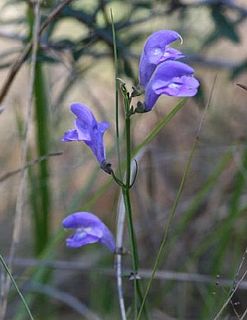
Scutellaria floridana, the Florida skullcap, is a rare species of flowering plant. It is endemic to Florida in the United States, where it is known only from the Florida Panhandle. It is threatened by a number of human activities and its small population sizes make it vulnerable. It is a federally listed threatened species.
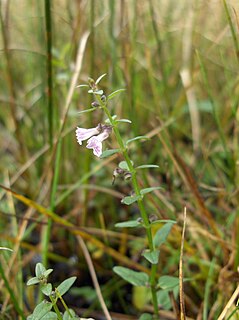
Scutellaria minor, the lesser skullcap, is a species of flowering plant in the family Lamiaceae.

Norwogonin, also known as 5,7,8-trihydroxyflavone (5,7,8-THF), is a flavone, a naturally occurring flavonoid-like chemical compound which is found in Scutellaria baicalensis. It has been found to act as an agonist of the TrkB, the main signaling receptor of brain-derived neurotrophic factor (BDNF), and appears to possess roughly the same activity in this regard to that of the closely related but more well-known 7,8-dihydroxyflavone (7,8-DHF).

Scutellaria parvula, commonly known as the small skullcap, is a member of the mint family. It is native to eastern and central North America, being most common in the central states and become rare in the east. It is found in areas that provide ample sunlight, such as prairies, glades, and savannas, often in calcareous soil. Flowering time is from late spring to early summer.

Scutellaria cardiophylla, known as gulf skullcap and heartleaf skullcap, is a species of flowering plant in the mint family. It is native to Texas, Louisiana, Arkansas, and Oklahoma; it is considered a rare/imperiled species across most of its range.

Scutellaria alabamensis, known as Alabama skullcap, is a rare and endangered wildflower, endemic only to 9 counties in North central Alabama.

Scutellaria brittonii, also known at Britton's skullcap, is a flowering perennial native to Wyoming, Colorado, New Mexico, Nebraska, and Kansas in the United States. It is classified under the genus Scutellaria and is also part of the mint family, Lamiacaea. It grows on dry mountain slopes and in full sun.


















